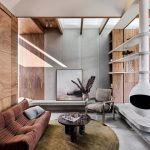Residential Rethinking: Covid-19 ‘home office’ dilemma
Covid-19 has dramatically shifted both commercial and residential needs as more businesses are adopting either a full or partial ‘work from home’ mandate as the pandemic is prevalent globally.
These measures, whilst smart for keeping the effects of the virus down by limiting close-contact with large swathes of people are stoking commercial landlords’ fears of serious structural changes to the office landscape.

GALLERY
However, as office market negative net absorption nears the -200,000sq m mark over the third quarter, a recent analysis of multi-residential projects reveals there is an opportunity for developers to pick up on serious unmet demand. Research by not-for-profit University of Melbourne alumni organisation Ignite ABP Network says that developers should consider creating dedicated co-working space in their projects.
“A home study may not be the best solution for the 88 per cent of people choosing to work from home after the pandemic,” researchers Trevor Du, Matko Matkovic and Derek Huynh said. “Evidently, there is an opportunity for developers to re-think the amenity mix and improve its relevance to purchasers post-pandemic.”
The trio’s research identified only one project of 35 recent Melbourne build-to-sell projects as offering a co-working space for residents. Before coronavirus, only 5 per cent, about one in 20 people, worked from home. Mandatory lockdowns and restrictions have pushed the number closer to 50 per cent, according to demographer Bernard Salt. “It has a major impact on the demand for commercial property and an impact on housing. The kind of housing you will need if there’s a step-change in the proportion of the workforce working from home.”
“It raises the question, what proportion will it go back to? Will it go back to four or 5 per cent?” Salt said. Speaking at the National Housing Finance and Investment Corporation webinar on employment and housing demand, Salt predicts a major step-change in the proportion of people working from home. “I say it will go back to maybe 10 per cent or 15 per cent. And I think it is the major cultural shift that I think will reshape the narrative of Australian life and change Australian housing.
As part of Huynh, Matkovic and Du’s research, they engaged a developer to evaluate whether the high demand for apartment co-working justified the replacement of other amenities in high-rise projects. “A 260 square metre space originally earmarked for a gym could accommodate up to 132 people per week if repurposed for apartment co-working. This is equivalent of about one full-time worker or three part-time workers per five square metres.”
Office markets recorded negative net absorption of -193,700 over the third quarter, according to JLL research. Five of the six monitored office markets recorded negative net absorption as corporates continue to assess headcount expectations for the next 12 to 18 months. “The economic crisis has negatively impacted business confidence,” JLL head of research Andrew Ballantyne said. “Corporate Australia is the new landlord in town with a sharp increase in sublease availability across the Sydney CBD and Melbourne CBD.”
Via Urban Developer
The Committee for Geelong has unveiled an ambitious $1 billion vision to transform the Market Square site from ...
Perched atop a modernist monolith, a 19th-century Lorrain-style house appears to hover above the skyline of Metz, France. This ...
New York-based studio Parts and Labor Design has redefined the classic American diner with its sophisticated refresh of ...
The Hug House is a masterclass in spatial layering, material richness, and seamless indoor-outdoor integration. Designed to embrace its ...
Perched atop one of Adelaide’s busiest CBD streets, SORA Rooftop & Bar is a venue defined by movement—both ...










